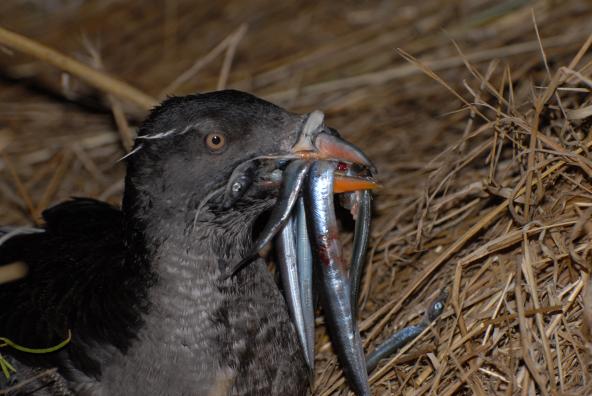Resilience to a severe marine heat wave at two Pacific seabird colonies (author summary)
A 2023 paper in the journal Marine Ecology Progress Series examines seabird reproductive and dietary response to a severe marine heat wave affecting the California Current ecosystem from 2014 to 2016. The study involved rhinoceros auklet colonies on Destruction Island (California Current) and Protection Island (Salish Sea). The paper's first author Eric Wagner describes some of the findings from the study in this informal summary.

Paper description and summary
In 2014, a huge patch of warm water started to grow in the northeastern Pacific. For the next three years, the patch expanded, and sea surface temperatures stayed unusually high. The patch would become known colloquially as the Blob, and nearly a decade after it started to roil the waters of the Pacific Northwest, researchers are still studying its ecological effects and aftershocks. For this paper, we drew on a long-term monitoring project to investigate the Blob’s effects at two large breeding colonies of rhinoceros auklets: one at Destruction Island, on the outer coast of Washington in the California Current, where about 6,500 pairs breed; and the other, at Protection Island, in the Strait of Juan de Fuca and the Salish Sea, where about 35,000 pairs breed.
Rhinoceros auklets are alcids, like murres and puffins. Alcids as a family tended to fare poorly during the Blob, with significant die-offs of common murres in Alaska and Cassin’s auklets off the west coast of North America, among other perturbations. As such, we expected to find that the rhinoceros auklets of Washington would also not do well. But when we related different metrics for breeding success at the two colonies — the rates at which birds laid eggs, and the rates at which chicks fledged — to marine conditions, we found neither profound nor consistent nor durable relationships between them. At Destruction Island, the Blob’s main effect appeared to be that auklets skipped breeding at slightly higher rates in 2014 and 2015, the heatwave’s first two years. At Protection Island, the main change was a decline in fledging success in 2015 and particularly 2016. None of these declines were especially catastrophic compared to those suffered by other birds up and down North America’s Pacific coastline.
What accounts for these patterns? Why did the auklets at the two islands respond to the Blob in different ways? It is hard to say exactly, but there are some clues found in what the auklets eat. Auklets at the Destruction Island colony have a diverse diet of forage fish. In some years they mostly brought back northern anchovy to their chicks; in other years, they brought back more whitebait smelt or surf smelt. They may have been able to switch prey, in other words, depending on what was more readily available. The auklets at Protection Island, on the other hand, may have consistently brought back Pacific sand lance and Pacific herring, but during the Blob years they brought back more fish per bill load. This helped them compensate for the fact that those fish were smaller in size than in really good years.
We reported one caveat. During 2016, there was a die-off of auklets in the Strait of Juan de Fuca. The cause was a bacterial pathogen, which caused pneumonia and septicemia. The risk of such disease outbreaks is predicted to rise as the seas warm. So while the auklets of Protection Island — and auklets in Washington more broadly — maybe have been able to withstand some of the Blob’s effects, whether they can endure everything that climate change promises to offer remains to be seen.
Citation
Wagner, E. L., Pearson, S. F., Good, T. P., Hodum, P. J., Buhle, E. R., & Schrimpf, M. B. (2023). Resilience to a severe marine heatwave at two Pacific seabird colonies. Marine Ecology Progress Series.

